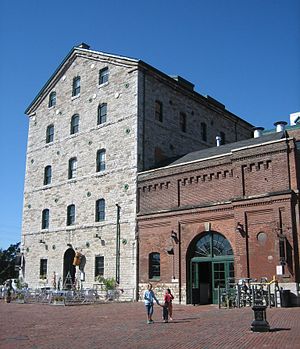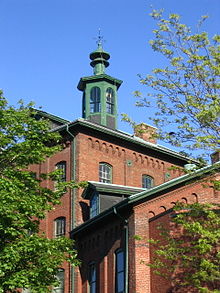- Distillery District
-
Distillery District — Neighbourhood — Distillery District street level Country  Canada
CanadaProvince  Ontario
OntarioCity  Toronto
TorontoGooderham and Worts Distillery National Historic Site of Canada 
The StonehouseProvince Ontario Original use Distillery Current use Mixed-use neighbourhood Designated as a NHSC 1988 Other designations Designated under the Ontario Heritage Act by City of Toronto by-law no. 154-76 Year built Existing historic buildings constructed between 1859 and 1927 Website Historic Distillery District The Distillery District is a historic and entertainment precinct located east of Downtown Toronto, Ontario, Canada. It contains numerous cafés, restaurants, and shops housed within heritage buildings of the former Gooderham and Worts Distillery. The 13-acre (52,000 sq. m) district comprises more than 40 heritage buildings and 10 streets, and is the largest collection of Victorian-era industrial architecture in North America.
The district was designated a National Historic Site of Canada in 1988.[1][2]
Contents
History
The Gooderham and Worts Distillery was founded in 1832, and by the late 1860s was the largest distillery in the world.[citation needed] Once providing over 2 million US gallons (7,600,000 L) of whisky, mostly for export on the world market, the company was bought out in later years by rival Hiram Walker Co., another large Canadian distiller. Its location on the side of the Canadian National Railway mainline and located at the mouth of the original route of the Don River outlet into Lake Ontario facilitated transport connections to the rest of Canada and the world, and the entire area was once the industrial centre of Toronto and a transshipping hub.
With the deindustrialization of the surrounding area in the late 20th century, and the winding-down of the distillery operations, the district was left increasingly derelict. Surrounding industrial and commercial buildings and structures were often demolished, leaving the former distillery surrounded primarily by empty lots. Nonetheless, the closing of the remaining distillery operations in 1990 created redevelopment and investment opportunities for a district that contained the largest and best preserved collection of Victorian-era industrial architecture in North America.
The economic recession of the early 1990s, however, and the resulting crash in residential condominium prices and office lease rates in downtown Toronto, delayed efforts to revitalize the district. Nonetheless, two residential condominium buildings were constructed on the periphery of the district during the late 1990s.
While the site awaited redevelopment and reinvestment, the district's unique ambiance began to attract numerous film shoots. Since 1990, the site has served as a location for over 800 film and television productions (see list).
Redevelopment
In 2001, the site was purchased by Cityscape Holdings Inc., which transformed the district into a pedestrian-oriented arts, culture, and entertainment neighbourhood. In 2003, the district was reopened to the public to great acclaim. The new owners refused to lease any of the retail and restaurant space to chains or franchises, and accordingly, the majority of the buildings are occupied with unique boutiques, art galleries, restaurants, jewellery stores, cafés, and coffeehouses, including a well-known microbrewery, the Mill Street Brewery. The upper floors of a number of buildings have been leased to artists as studio spaces and to office tenants with a "creative focus". A new theatre, the Young Centre for the Performing Arts, has opened on the site and serves as the home of the Soulpepper Theatre Company and the drama productions of nearby George Brown College. There are plans to develop residential condominiums, offices, and more retail space on the vacant lands that surround the district.
There has been some criticism of the district's redevelopment.[by whom?] Some have suggested that the area's gentrification has resulted in yet another upscale shopping district competing for the money of a wealthy demographic, and that opportunities for more publicly funded uses have been lost.[citation needed] In contrast, others[who?] have noted that the district provides important space to local artists, and are supportive of the fact that the district is not dominated by large retail chains.[citation needed]
Regardless of any criticism, the preservation and active reuse of the historic buildings has been widely praised.[citation needed] The Distillery District is a National Historic Site, and has been designated for protection under the Ontario Heritage Act since 1976. It was listed by National Geographic magazine as a "top pick" in Canada for travellers. The redevelopment of surrounding vacant lands is expected to accelerate the district's transformation from an abandoned industrial site into one of Toronto's most distinctive neighbourhoods.
Buildings
 The Cooperage with its prominent cupola
The Cooperage with its prominent cupola
The former distillery consisted of a series of buildings, centred around a seven-storey windmill and wharf. Although the windmill and wharf have long since been demolished, the inventory of the main structures on the site is as follows:
- the Stonehouse Distillery, designed by David Roberts Sr., near the then shoreline of Lake Ontario;
- a 31-metre (100 ft) chimneystack;
- the Malt House (built in 1860), now called the Maltings;
- Double-D Rackhouse;
- the Molasses Storage building;
- the Boiler House;
- the Stables;
- the Cannery;
- the Paint Shop;
- the various tankhouses (originally seven of which only three survive today);
- the Denaturing Room;
- the Crapper;
- Rack Houses M, G, and J;
- the Pump House;
- the Case Goods Warehouse;
- the Wharf (now demolished);
- the Cooperage;
- the Outhouse;
- the Grain Elevator and Warehouse, located at the wharf (and since demolished);
- the Pure Spirits Building (built in 1870); and
- the Grist Mill/Windmill, which was built in 1832 at a height of 21 metres (71 ft). It ceased to be a windmill in 1846, and was rebuilt after damage from a storm in the 1850s and disappeared by 1866. A replica was built in 1954, but it was demolished to make way for the Gardiner Expressway.
See also
- List of oldest buildings and structures in Toronto
- Gooderham Building - Built to hold the offices of the Gooderham & Worts Distillery
References
- ^ Gooderham and Worts Distillery, Directory of Designations of National Historic Significance of Canada
- ^ Gooderham and Worts Distillery, National Register of Historic Places
External links
- Distillery District website
- Events at The Distillery District
- Historic Distillery District
- Jaded tourists wowed by Gooderham & Worts
- The Gooderham and Worts Factory Complex (now the Distillery District)
- Miss Whisky — The Rise And Fall of Canada's Forgotten Distillery
- Facts of Wind Energy
- Balancing Heritage Conservation in the Private Sector: A case study of the Distillery District in Toronto a video presentation by Michael McClelland, E.R.A. Architects Inc., February 16, 2006
- Distillery Heritage website

Regent Park
Moss Park
Corktown
Financial District
St. Lawrence
Riverdale
West Don Lands Distillery District
Distillery District 

East Bayfront District  National Historic Sites of Canada by location
National Historic Sites of Canada by locationProvinces Territories Northwest Territories · Nunavut · YukonOther countries FranceCoordinates: 43°39′2.628″N 79°21′35.1714″W / 43.65073°N 79.359769833°W
Categories:- Neighbourhoods in Toronto
- Warehouse districts
- Historic districts in Canada
- Economy of Toronto
- National Historic Sites in Ontario
- Restaurant districts and streets
- Distilleries in Canada
Wikimedia Foundation. 2010.




